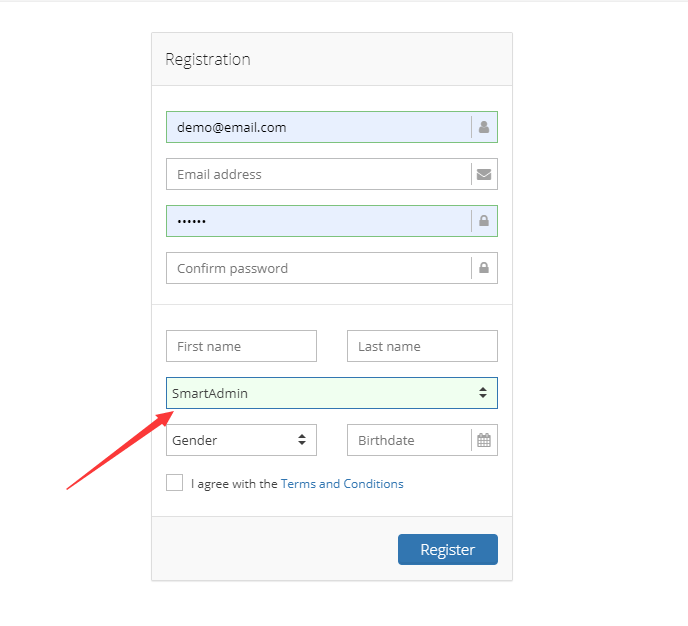本篇文章为大家展示了使用EF6怎么实现一个多租户应用,内容简明扼要并且容易理解,绝对能使你眼前一亮,通过这篇文章的详细介绍希望你能有所收获。
什么是多租户
网上有好多解释,有些上升到了架构设计,让你觉得似乎非常高深莫测,特别是目前流行的ABP架构中就有提到多租户(IMustHaveTenant),其实说的简单一点就是再每一张数据库的表中添加一个TenantId的字段,用于区分属于不同的租户(或是说不同的用户组)的数据。关键是现实的方式必须对开发人员来说是透明的,不需要关注这个字段的信息,由后台或是封装在基类中实现数据的筛选和更新。
基本原理
从新用户注册时就必须指定用户的TenantId,我的例子是用CompanyId,公司信息做为TenantId,哪些用户属于不同的公司,每个用户将来只能修改和查询属于本公司的数据。
接下来就是用户登录的时候获取用户信息的时候把TenantId保存起来,asp.net mvc(不是 core) 是通过 Identity 2.0实现的认证和授权,这里需要重写部分代码来实现。
最后用户对数据查询/修改/新增时把用户信息中TenantId,这里就需要设定一个Filter(过滤器)和每次SaveChange的插入TenantId
如何实现
第一步,扩展 Asp.net Identity user 属性,必须新增一个TenantId字段,根据Asp.net Mvc 自带的项目模板修改IdentityModels.cs 这个文件
// You can add profile data for the user by adding more properties to your ApplicationUser class, please visit http://go.microsoft.com/fwlink/?LinkID=317594 to learn more. public class ApplicationUser : IdentityUser
{
public async Task<ClaimsIdentity> GenerateUserIdentityAsync(UserManager<ApplicationUser> manager, string authenticationType)
{
// Note the authenticationType must match the one defined in CookieAuthenticationOptions.AuthenticationType var userIdentity = await manager.CreateIdentityAsync(this, authenticationType);
// Add custom user claims here userIdentity.AddClaim(new Claim("http://schemas.microsoft.com/identity/claims/tenantid", this.TenantId.ToString()));
userIdentity.AddClaim(new Claim("CompanyName", this.CompanyName));
userIdentity.AddClaim(new Claim("EnabledChat", this.EnabledChat.ToString()));
userIdentity.AddClaim(new Claim("FullName", this.FullName));
userIdentity.AddClaim(new Claim("AvatarsX50", this.AvatarsX50));
userIdentity.AddClaim(new Claim("AvatarsX120", this.AvatarsX120));
return userIdentity;
}
public async Task<ClaimsIdentity> GenerateUserIdentityAsync(UserManager<ApplicationUser> manager)
{
// Note the authenticationType must match the one defined in CookieAuthenticationOptions.AuthenticationType var userIdentity = await manager.CreateIdentityAsync(this, DefaultAuthenticationTypes.ApplicationCookie);
// Add custom user claims here return userIdentity;
}
[Display(Name = "全名")]
public string FullName { get; set; }
[Display(Name = "性别")]
public int Gender { get; set; }
public int AccountType { get; set; }
[Display(Name = "所属公司")]
public string CompanyCode { get; set; }
[Display(Name = "公司名称")]
public string CompanyName { get; set; }
[Display(Name = "是否在线")]
public bool IsOnline { get; set; }
[Display(Name = "是否开启聊天功能")]
public bool EnabledChat { get; set; }
[Display(Name = "小头像")]
public string AvatarsX50 { get; set; }
[Display(Name = "大头像")]
public string AvatarsX120 { get; set; }
[Display(Name = "租户ID")]
public int TenantId { get; set; }
}
public class ApplicationDbContext : IdentityDbContext<ApplicationUser>
{
public ApplicationDbContext()
: base("DefaultConnection", throwIfV1Schema: false) => Database.SetInitializer<ApplicationDbContext>(null);
public static ApplicationDbContext Create() => new ApplicationDbContext();
}第二步 修改注册用户的代码,注册新用户的时候需要选择所属的公司信息

[HttpPost]
[AllowAnonymous]
[ValidateAntiForgeryToken]
public async Task<ActionResult> Register(AccountRegistrationModel viewModel)
{
var data = this._companyService.Queryable().Select(x => new ListItem() { Value = x.Id.ToString(), Text = x.Name });
this.ViewBag.companylist = data;
// Ensure we have a valid viewModel to work with if (!this.ModelState.IsValid)
{
return this.View(viewModel);
}
// Try to create a user with the given identity try {
// Prepare the identity with the provided information var user = new ApplicationUser
{
UserName = viewModel.Username,
FullName = viewModel.Lastname + "." + viewModel.Firstname,
CompanyCode = viewModel.CompanyCode,
CompanyName = viewModel.CompanyName,
TenantId=viewModel.TenantId,
Email = viewModel.Email,
AccountType = 0
};
var result = await this.UserManager.CreateAsync(user, viewModel.Password);
// If the user could not be created if (!result.Succeeded)
{
// Add all errors to the page so they can be used to display what went wrong this.AddErrors(result);
return this.View(viewModel);
}
// If the user was able to be created we can sign it in immediately // Note: Consider using the email verification proces await this.SignInAsync(user, true);
return this.RedirectToLocal();
}
catch (DbEntityValidationException ex)
{
// Add all errors to the page so they can be used to display what went wrong this.AddErrors(ex);
return this.View(viewModel);
}
}
AccountController.cs第三步 读取登录用户的TenantId 在用户查询和新增修改时把TenantId插入到表中,这里需要引用
Z.EntityFramework.Plus,这个是免费开源的一个类库,功能强大
public StoreContext()
: base("Name=DefaultConnection") {
//获取登录用户信息,tenantid var claimsidentity = (ClaimsIdentity)HttpContext.Current.User.Identity;
var tenantclaim = claimsidentity?.FindFirst("http://schemas.microsoft.com/identity/claims/tenantid");
var tenantid = Convert.ToInt32(tenantclaim?.Value);
//设置当对Work对象进行查询时默认添加过滤条件 QueryFilterManager.Filter<Work>(q => q.Where(x => x.TenantId == tenantid));
//设置当对Order对象进行查询时默认添加过滤条件 QueryFilterManager.Filter<Order>(q => q.Where(x => x.TenantId == tenantid));
}
public override Task<int> SaveChangesAsync(CancellationToken cancellationToken) {
var currentDateTime = DateTime.Now;
var claimsidentity = (ClaimsIdentity)HttpContext.Current.User.Identity;
var tenantclaim = claimsidentity?.FindFirst("http://schemas.microsoft.com/identity/claims/tenantid");
var tenantid = Convert.ToInt32(tenantclaim?.Value);
foreach (var auditableEntity in this.ChangeTracker.Entries<Entity>())
{
if (auditableEntity.State == EntityState.Added || auditableEntity.State == EntityState.Modified)
{
//auditableEntity.Entity.LastModifiedDate = currentDateTime; switch (auditableEntity.State)
{
case EntityState.Added:
auditableEntity.Property("LastModifiedDate").IsModified = false;
auditableEntity.Property("LastModifiedBy").IsModified = false;
auditableEntity.Entity.CreatedDate = currentDateTime;
auditableEntity.Entity.CreatedBy = claimsidentity.Name;
auditableEntity.Entity.TenantId = tenantid;
break;
case EntityState.Modified:
auditableEntity.Property("CreatedDate").IsModified = false;
auditableEntity.Property("CreatedBy").IsModified = false;
auditableEntity.Entity.LastModifiedDate = currentDateTime;
auditableEntity.Entity.LastModifiedBy = claimsidentity.Name;
auditableEntity.Entity.TenantId = tenantid;
//if (auditableEntity.Property(p => p.Created).IsModified || auditableEntity.Property(p => p.CreatedBy).IsModified) //{ // throw new DbEntityValidationException(string.Format("Attempt to change created audit trails on a modified {0}", auditableEntity.Entity.GetType().FullName)); //} break;
}
}
}
return base.SaveChangesAsync(cancellationToken);
}
public override int SaveChanges() {
var currentDateTime = DateTime.Now;
var claimsidentity =(ClaimsIdentity)HttpContext.Current.User.Identity;
var tenantclaim = claimsidentity?.FindFirst("http://schemas.microsoft.com/identity/claims/tenantid");
var tenantid = Convert.ToInt32(tenantclaim?.Value);
foreach (var auditableEntity in this.ChangeTracker.Entries<Entity>())
{
if (auditableEntity.State == EntityState.Added || auditableEntity.State == EntityState.Modified)
{
auditableEntity.Entity.LastModifiedDate = currentDateTime;
switch (auditableEntity.State)
{
case EntityState.Added:
auditableEntity.Property("LastModifiedDate").IsModified = false;
auditableEntity.Property("LastModifiedBy").IsModified = false;
auditableEntity.Entity.CreatedDate = currentDateTime;
auditableEntity.Entity.CreatedBy = claimsidentity.Name;
auditableEntity.Entity.TenantId = tenantid;
break;
case EntityState.Modified:
auditableEntity.Property("CreatedDate").IsModified = false;
auditableEntity.Property("CreatedBy").IsModified = false;
auditableEntity.Entity.LastModifiedDate = currentDateTime;
auditableEntity.Entity.LastModifiedBy = claimsidentity.Name;
auditableEntity.Entity.TenantId = tenantid;
break;
}
}
}
return base.SaveChanges();
}
DbContext.cs上述内容就是使用EF6怎么实现一个多租户应用,你们学到知识或技能了吗?如果还想学到更多技能或者丰富自己的知识储备,欢迎关注辰讯云。
辰迅云「云服务器」,即开即用、新一代英特尔至强铂金CPU、三副本存储NVMe SSD云盘,价格低至29元/月。点击查看>>
推荐阅读: c#中static的用法是什么